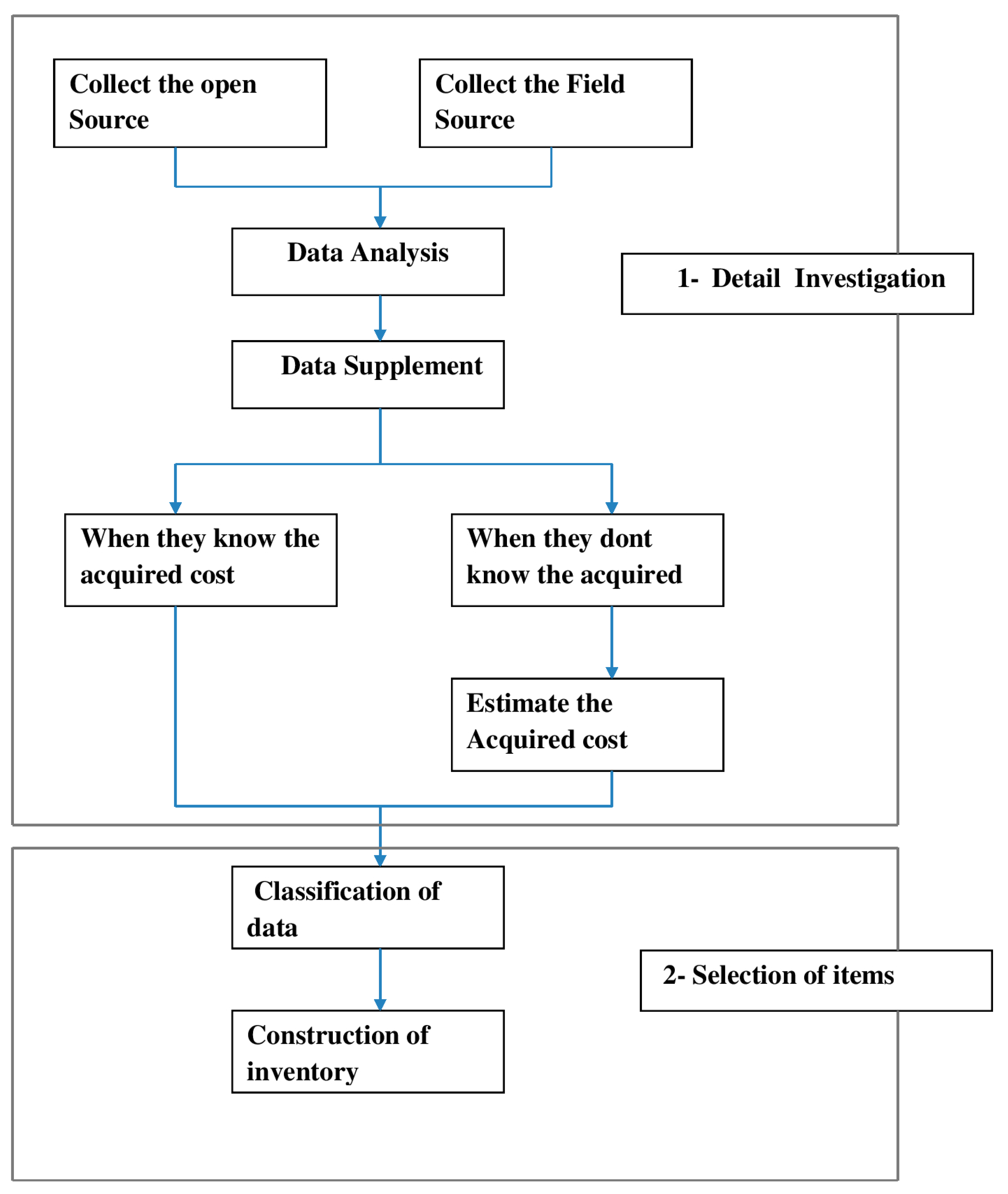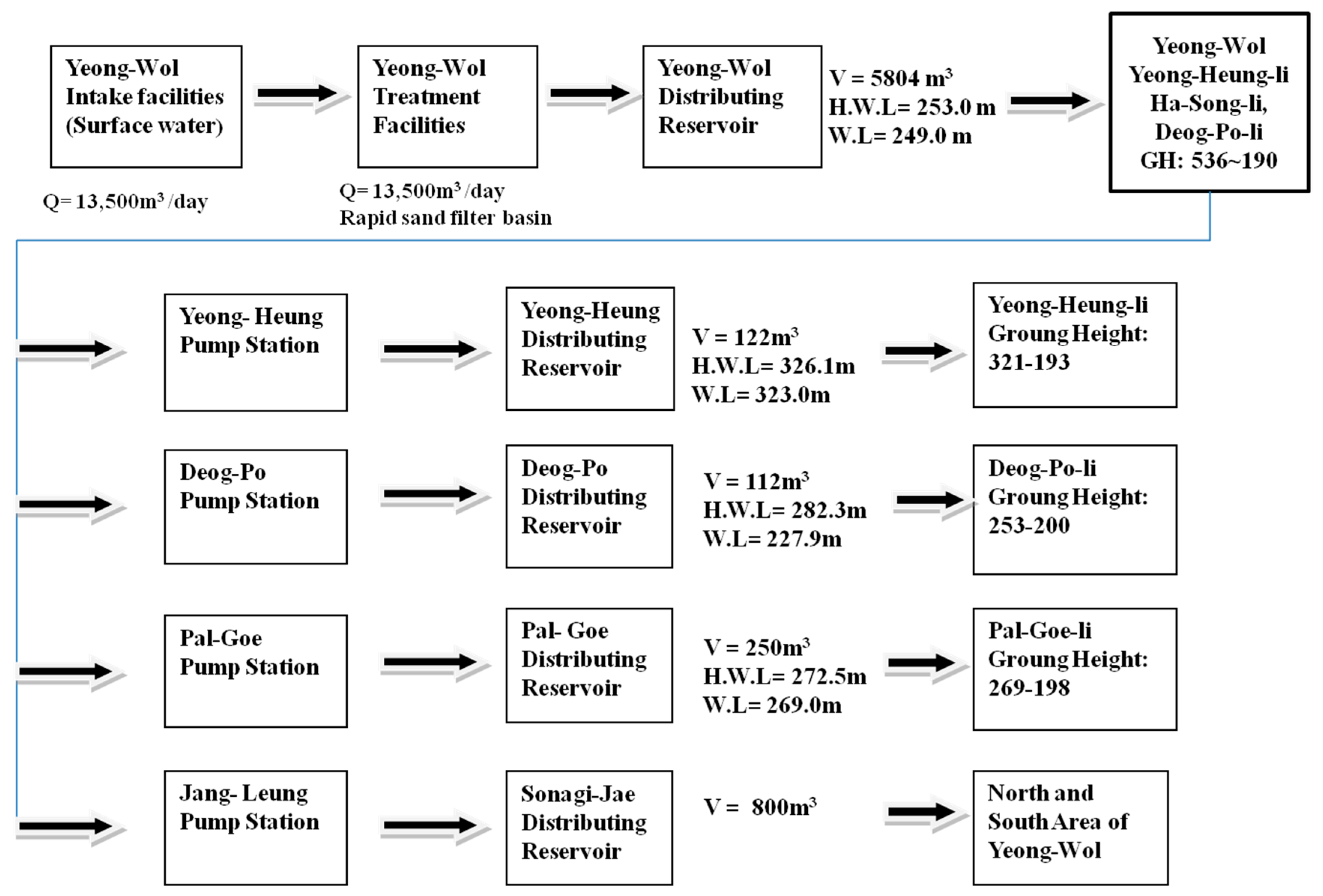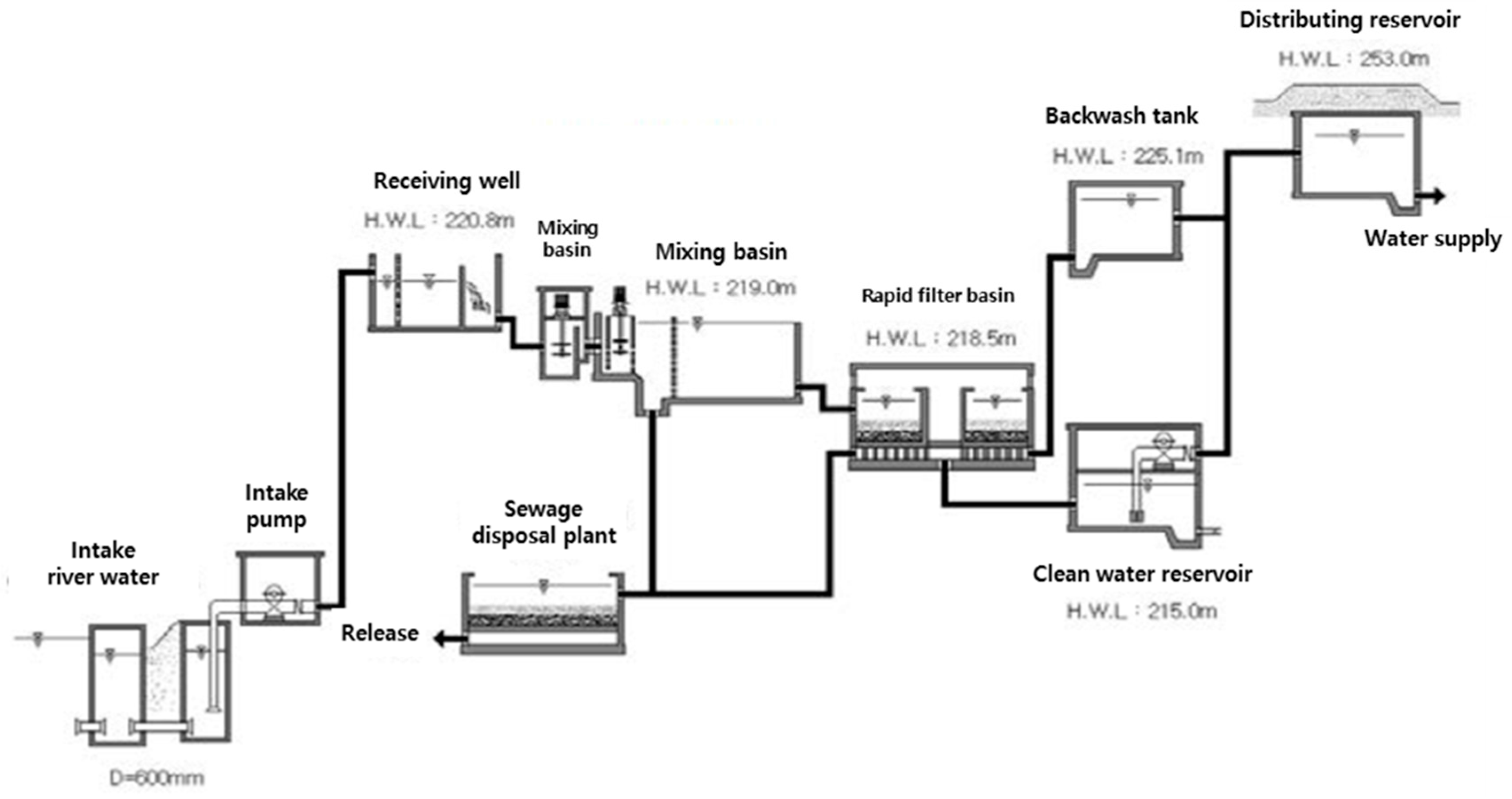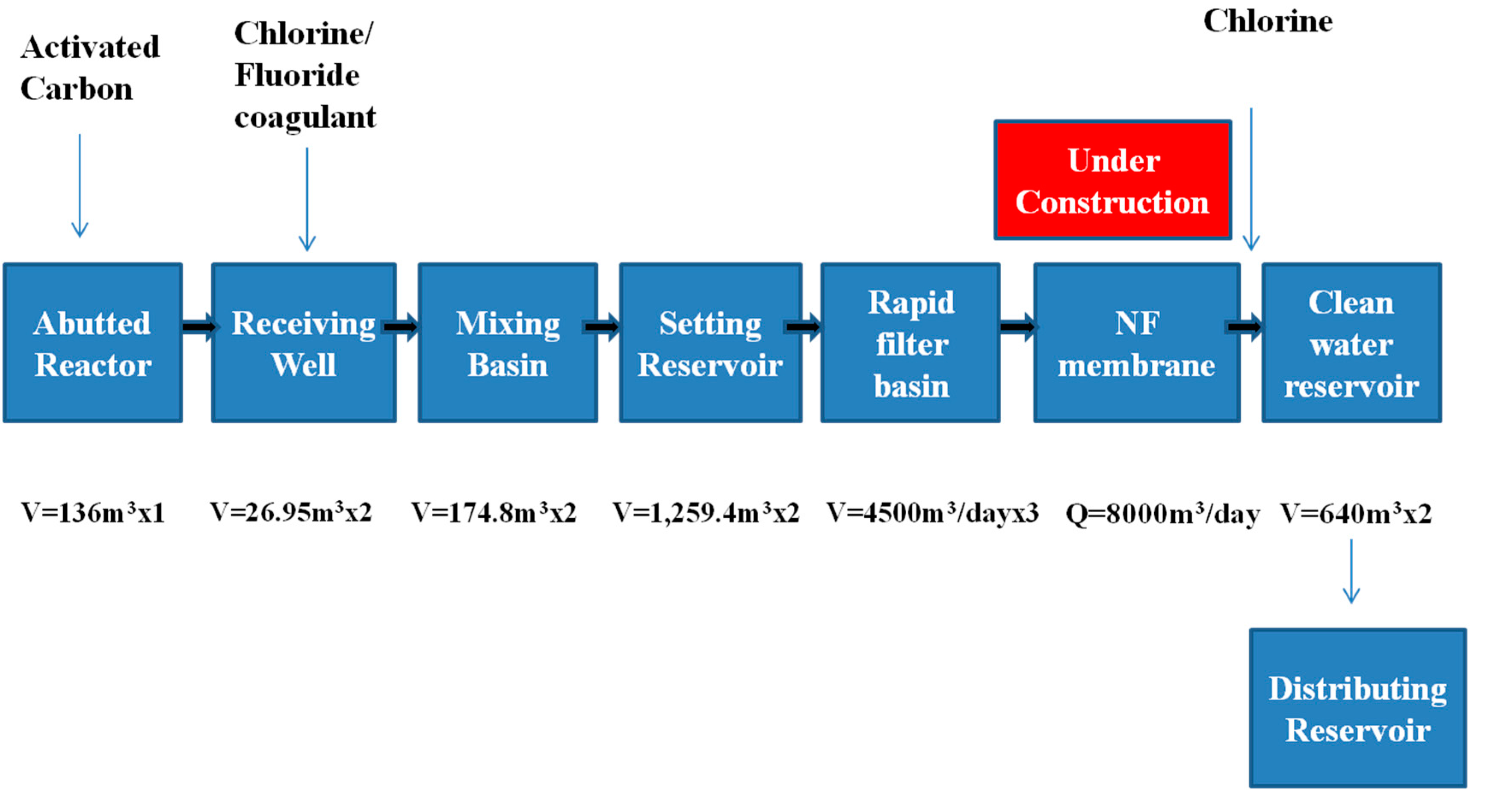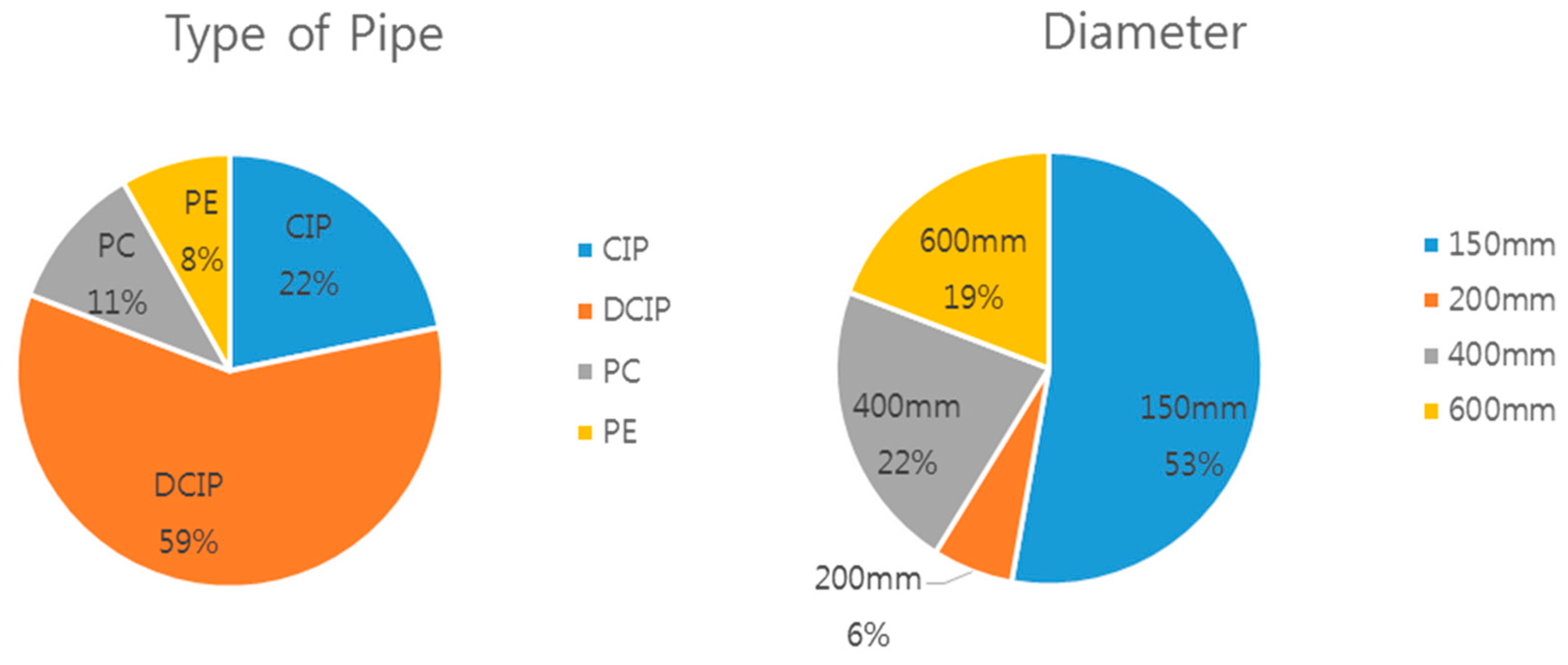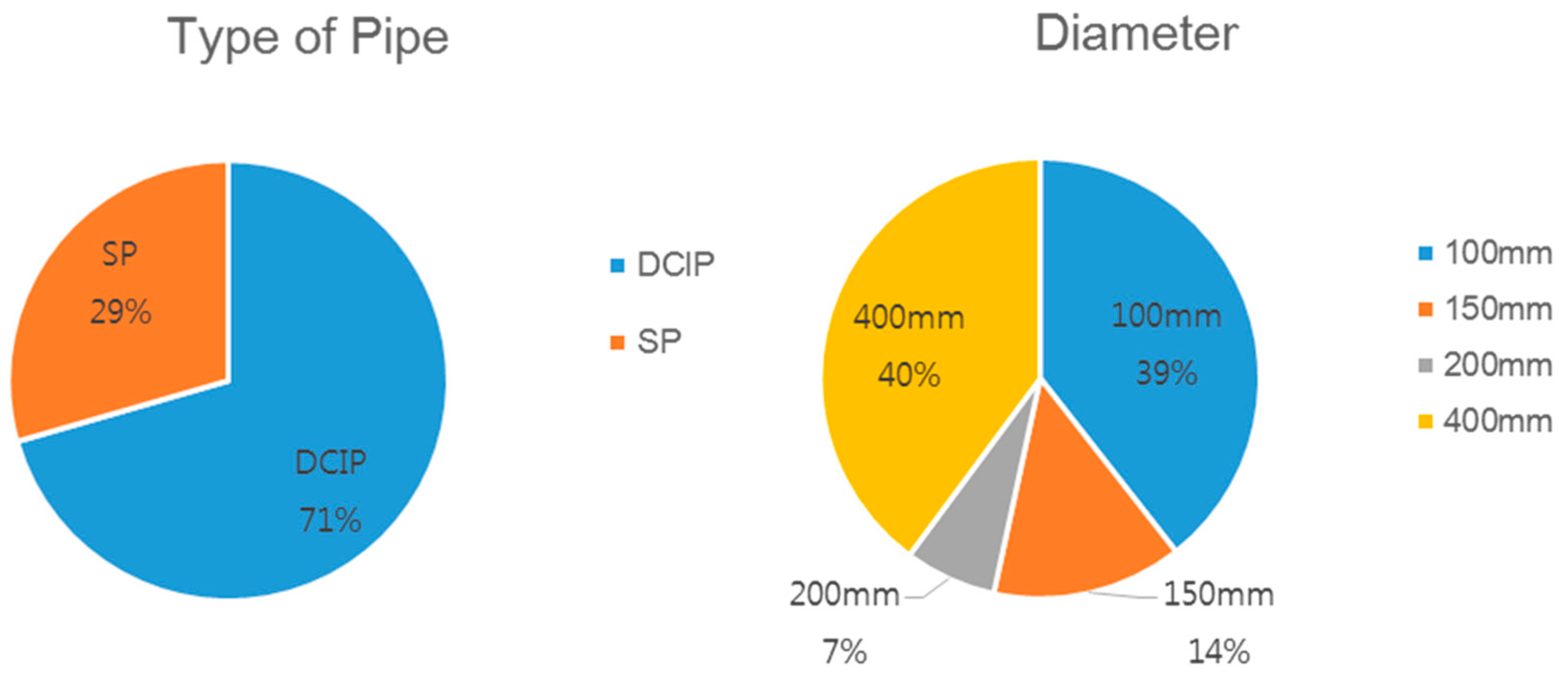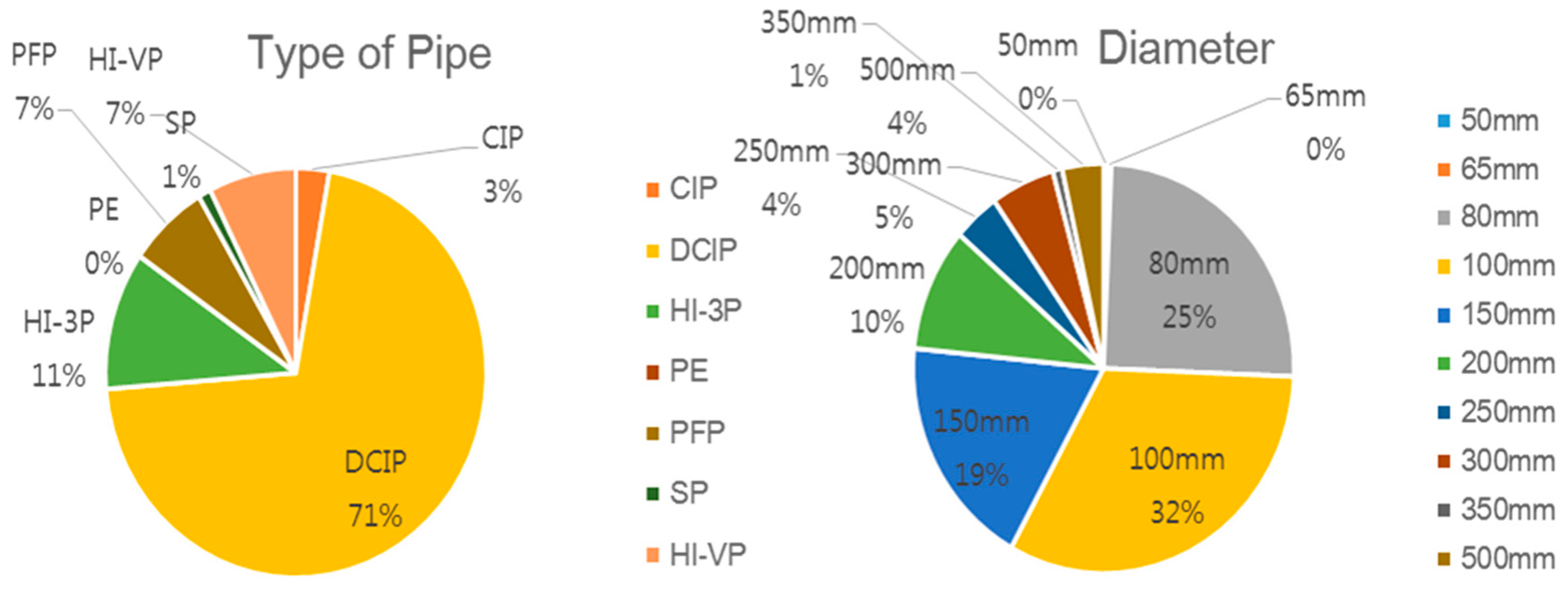1. Introduction
The purpose of water supply systems is to provide water to consumers in a stable way while satisfying both the demand of consumers and the goals of the supplier. To accomplish this purpose, it is necessary to operate and maintain water supply facilities in a systematic way. A water supply facility is a type of infrastructure that owns and operates a range of equipment and buildings, and in order to operate these, ongoing maintenance by a facility manager is required [
1].
About 161 regional waterworks operators (special metropolitan cities (7), special self-governing cities (1), special self-governing provinces (1), cities (75), guns (77)) and multi-regional waterworks operators (1))) covered 98.6% of the total population (approximately 51,712,000 persons) as of the end of December 2014 [
2] in South Korea
The life cycle cost (LCC) is the cost of an asset, or its parts throughout its life cycle, while fulfilling the performance requirements. (BS ISO 15686-5, 3.1.1.7).
LCC may be used during following four stages of the life cycle of any constructed asset:
- (a)
Project investment and planning; Whole life costing/ Life cycle cost (WLC/LCC) strategic option analyses; preconstruction;
- (b)
Design and construction; LCC during construction, at scheme, functional, system and detailed component levels;
- (c)
During occupation; LCC during occupation (cost-in-use); post-construction; and
- (d)
Disposal; LCC at end-of-life/end-of-interest. (BS ISO 15686-5:2008).
According to a literature review of life cycle costing and life cycle assessment, there are four important steps in life cycle costing:
The first step is to generate cost profiles corresponding to each considered option. Each cost profile is a series of planning, construction, maintenance, support, use, and disposal cost estimates calculated over the intended service life of the corresponding facility option.
Next, each cost profile is translated to an equivalence measure to support a common and credible basis of comparison among the considered options.
Third, the results of the time value of the money computations are used to rank the options according to life cycle cost.
Finally, the results of the LCC procedure are passed on to the infrastructure owner to support rational decision making.
Life cycle assessment (LCA) is a technique for assessing potential environmental aspects and potential aspects associated with a product (or service), by:
Compiling an inventory of relevant inputs and outputs;
Evaluating the potential environmental impacts associated with those inputs and outputs; and
Interpreting the results of the inventory and impact phases in relation to the objectives of the study. (ISO 14040.2 Draft: Life Cycle Assessment—Principles and Guidelines)
According to ISO 14040, LCA is divided into four phases:
Life cycle assessment (LCA) is necessary for defining the best environmental management strategies. Anna [
3] studied the environmental impacts of a sewer system and determined the most environmentally friendly design strategy for small to medium sized cities by composing an inventory of the materials and energy. Establishing an inventory is the basic step for LCA or LCC analysis. Sanjuan [
4] statistically analyzed 50 cities to find the relations between different variables regarding water consumption linked with the environmental impact of a network.
Social life cost assessment (SLCA) is defined as the methodology for the assessment of positive and negative social impacts that are generated by a product/service in its life cycle and in relation to the different groups of stakeholders involved, with the aim of promoting the improvement of a product’s socio-economic performance throughout its life cycle [
5].
Studies of the introduction of maintenance and management systems with the life cycle cost (LCC) analysis technique applied have been continuously conducted in an effort to efficiently utilize the limited amount of budget and prevent costs for maintenance and management from rapidly rising. One of the important things about the maintenance of a water supply network is calculating the optimum time for the replacement of water supply pipes. For that purpose technical–economic analyses have been used to take into account all kinds of costs for the repair or replacement of trouble-causing parts of a network [
6]. Yoon [
7] reviewed and compared the advantages of four different design cases, presenting the optimal techniques and tasks that should be carried out in order to maximize the economic utility of a project through LCC analysis. Applying the LCC method, Lee [
8] compared the LCCs of modern hanok housing and apartment housing in order to provide basic information for the choice of housing A series of systems which are carried out to satisfy the minimum life cycle cost of a water supply system and to reach the desired level of service are defined as asset management [
9]. Previously, life cycle assessment research in the area of water cycle management has mainly discussed specific aspects of wastewater systems, i.e., quantifying the environmental load of wastewater systems [
10,
11,
12,
13,
14] or biosolid systems [
15,
16]. Life cycle assessment has also been used for the definition of environmental sustainability indicators for wastewater systems [
17,
18] and more recently for urban water systems [
19]. Son [
20] analyzed the economic valuation of sewage disposal facilities and suggested, based on the results of the LCC analysis, that it would be more economically feasible to directly operate such facilities for the first four to five years and then switch to a consignment operating system.
Heo [
21], in his study, selected a strategic simulation for the repair, rehabilitation and improved performance of existing dam structures using LCC analysis techniques. Life cycle assessments consist of three main steps and a generally acknowledged fourth step: (1) goal definition and scoping (generally included); (2) inventory analysis; (3) impact analysis; and (4) improvement analysis [
22,
23].
The work that is pre-required to analyze an LCC is the classification of the asset according to the classification systems of water supply systems. Any facility must be arranged to determine the current status of the management. To analyze the LCC of water supply systems, it is necessary to grasp the current status of assets and classify the assets of the water supply system in advance. That is, the management of any facility should be preceded by the understanding of the current conditions.
This paper focuses on the classification of an inventory of a water supply system that is the basis of an LCC analysis of the water supply system. This classification makes inventory establishment for LCC analysis easy because, in a water supply system, there are many machines and items involved, and with the help of this classification each and every item can be identified in more depth. It also tells the waterworks manager when, where and which item needs to be repaired, rehabilitated and replaced.
Methodology of the Classification System of a Water Supply System
Water supply systems are classified into three levels, and the types are classified at the first level (category), and sub-facilities under each category item are classified at the second level (subcategory). The composition of each sub-facility is defined at the third level (sub-sub category).
The types of water supply system are classified at the level of “category”, and target water supply systems are divided into six categories including water intake facilities, water conveyance facilities, water treatment facilities, water transmission facilities, water distribution facilities and water supply facilities.
The sub-facilities of each category are classified at the level of “subcategory”, and they are distinguished by function and use, or structure and form.
At the level of sub-sub category, civil engineering structures, facilities and equipment that compose each type of sub-facility are classified according to sub-sub category items by function or structure or form. They are, in turn, divided in detail into pipe, pump, valve, water gate, tank, machine, special, measurement, and others as shown in the following table.
Table 1 shows the sub-sub category items and their descriptions.
3. Results and Discussion
Based on the theoretical review, the standards of water supply systems were systematically revised and supplemented. The developed program was set to ensure administrators can modify levels or content.
In analyzing the water supply systems in this study, water treatment facilities were excluded to focus on pipelines. The data used in this study were established based on real data from the YW pipeline systems.
Inventories of water supply systems were divided into five levels, and the higher the level, the more detailed facilities are classified. The
Table 3,
Table 4,
Table 5,
Table 6 and
Table 7 show the classification of facilities from Level 1 to Level 5.
The tables above indicate that the classification scheme has a hierarchical structure. All the detailed contents above are just listed by level, not in order of any importance.
The paper divided the water supply system broadly into five different levels for the establishment of an inventory, that is, the basic step for LCC analysis. The above table indicates that the classification scheme has a hierarchical structure. The hierarchical structure is shown in
Supplementary Materials. In the previous literature there is no such kind of classification. Water supply systems were divided into five levels, and the higher the level, the more detailed facilities were classified. The preceding tables show the classification of facilities from Level 1 to Level 5. In conclusion, water supply systems were divided into five levels, and to analyze each facility, data from the YW pipeline system were utilized. In Levels 4 and 5, the types and diameters of pipes were identified to easily distinguish their different characteristics. The following table shows an example of the establishment of an inventory.
Generalization of Inventory Composition
The establishment of an inventory of water supply systems was prioritized first in this study, but it was also important to select inventory items. There were certain necessary items that should exist in an inventory program when LCC is analyzed or data are accumulated.
Based on the data acquired from fields, the necessary items for LCC analysis were established in consultation with experts in water supply systems as shown in
Table 8 and
Table 9.
Also, diagnosis result should be contained in the inventory items. To prevent any loss of data or items caused by the careless operation of some users, only administrators are allowed to change, add or delete inventory items.
